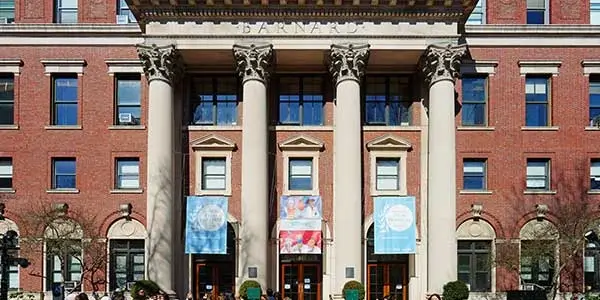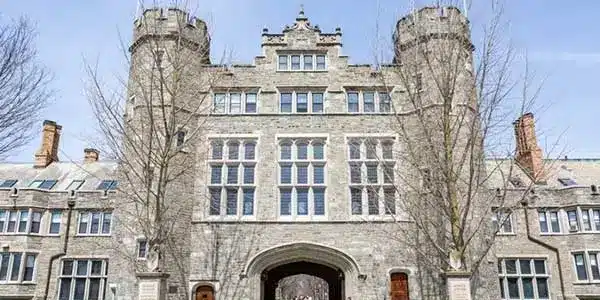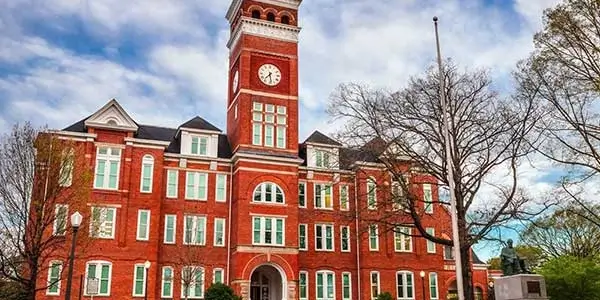Are you in search of a college that not only provides a high-quality education but also ensures a secure and encouraging environment for female students? If that’s the case, you might find this compilation of the best 8 Safest Colleges for Females in the USA. The list is based on data gathered from various sources like Niche.com, College Reality Check, U.S. News & World Report, and Google Scholar.
Introduction:
What Constitutes a Safe College for Females? The term “safety” can encompass different meanings for different individuals. Nevertheless, there are several common factors that contribute to a college being considered safe for female students:
- Low rates of crime, particularly violent crime, and sexual assault.
- Effective security measures and policies, including campus police, emergency phones, well-lit areas, surveillance cameras, and more.
- Supportive services and resources tailored to female students, such as counseling, healthcare facilities, advocacy programs, and so on.
- A culture that fosters respect, inclusion, gender equity, and diversity.
- A strong sense of community and belonging among female students and faculty members
According to these standards, the following list presents the top 8 colleges in the United States that provide a secure environment for female students, listed in no specific order:
Women ‘s Colleges:
- Wellesley College
- Smith College
- Barnard College
- Bryn Mawr College
- Mount Holyoke College
Co-educational Colleges:
- Brigham Young University
- New York University
- Clemson University
| Sr.No | Women ‘s Colleges | Location | Niche Ranking |
| 1 | Wellesley College | Wellesley, Massachusetts | #2 |
| 2 | Smith College | Northampton, Massachusetts | #3 |
| 3 | Barnard College | New York City, New York | #1 |
| 4 | Bryn Mawr College | Bryn Mawr, Pennsylvania | #5 |
| 5 | Mount Holyoke College | South Hadley, Massachusetts | #6 |
Co-educational Colleges
| Sr.No | Co-educational Colleges | Location | US NEWS RANKING |
| 6 | Brigham Young University | Rexburg, Idaho | #89 in National Universities |
| 7 | New York University | New York City, New York | #25 in National Universities |
| 8 | Clemson University | Clemson, South Carolina | #77 in National Universities |
These figures on criminal activity are sourced from the Campus Safety Division of the U.S. Department of Education.
Wellesley College:

Wellesley College, located in Massachusetts, is a highly regarded women’s liberal arts college and a member of the esteemed Seven Sisters group. It has earned a reputation for its outstanding academic standards, the development of leadership skills, and its extensive network of successful alumnae, which includes notable figures such as Hillary Clinton, Madeleine Albright, Diane Sawyer, and Nora Ephron. Wellesley College provides a supportive and empowering environment specifically tailored for women, and it is recognized as one of the safest colleges for females in the United States, as affirmed by College Reality Check. The college maintains low rates of crime and sexual assault incidents.
According to recent data from 2019, Wellesley College reported a total of 16 incidents related to crime and safety. These incidents involved students and occurred either on campus, in close proximity to the campus, or on other affiliated properties. Considering the student population of 2,519, this translates to an average of 6.35 incidents per 1,000 students. It is worth noting that this figure provides a context for comparison, alongside the maximum number of incidents reported by any institution included in our analysis.
Please Refer to the table below for a breakdown of the incidents by category.
| Category | Total Incidents | Maximum Incidents (at any school) | Incidents per 1,000 students | Maximum Incidents per 1000 students (at any school) |
| Arrests related to Serious Offenses | 11 | 1,670 | 4.37 | 4,000.00 |
| Arrests for Possessing | 0 | 880 | 0.00 | 1,352.94 |
| Crimes of Violence Targeting Women | 5 | 334 | 1.98 | 1,000.00 |
| Disciplinary Actions | 0 | 2,670 | 0.00 | 4,574.85 |
Smith College:

Smith College is recognized as one of the prestigious Seven Sisters institutions and is highly regarded as a top-tier liberal arts college for women in the United States. It is a moderately competitive school, admitting approximately 32.5% of applicants. Among its popular fields of study are Economics, Political Science, and English Language and Literature.
Smith College provides a nurturing and empowering atmosphere for women and has earned a favorable ranking as one of the safest colleges for female students in the country, according to College Reality Check. The college boasts low rates of crime and sexual assault on campus.
Based on the latest available data from 2019, Smith College disclosed information regarding crime and safety incidents involving students on or near campus, as well as other properties affiliated with the institution. Considering the total student population of 2,894 at that time, the college reported a rate of 19.70 incidents per 1,000 students and 57 incidents.
Below, you can find a breakdown of incidents by category, along with the highest number of incidents reported by any institution for comparison purposes.
| Category | Total Incidents | Maximum Incidents (at any school) | Incidents per 1,000 students | Maximum Incidents per 1000 students (at any school) |
| Arrests related to Serious Offenses | 26 | 1,670 | 8.98 | 4,000.00 |
| Arrests for Possessing | 0 | 880 | 0.00 | 1,352.94 |
| Crimes of Violence Targeting Women | 6 | 334 | 2.07 | 1,000.00 |
| Disciplinary Actions | 25 | 2,670 | 8.64 | 4,574.85 |
Barnard College:

Barnard College is renowned for being the most exclusive among the Seven Sisters schools and maintains an affiliation with Columbia University. The college offers a range of prominent majors, including Social Sciences, Biomedical Sciences, Psychology, and Literature. Notably, when it was established, Barnard College became the first educational institution in New York City to grant degrees to women.
Based on recent data in 2019, Barnard College recorded a total of 96 incidents related to crime and safety. These incidents involved students and occurred either on or near the campus or on other affiliated properties. With a student population of 2,631, this translates to an average of 36.49 incidents per 1,000 students.
To provide a clearer representation of the data, the table below illustrates the number of incidents categorized by type, along with the highest number of incidents reported by any school within that specific category.
| Category | Total Incidents | Maximum Incidents (at any school) | Incidents per 1,000 students | Maximum Incidents per 1000 students (at any school) |
| Arrests related to Serious Offenses | 8 | 1,670 | 3.04 | 4,000.00 |
| Arrests for Possessing | 1 | 880 | 0.38 | 1,352.94 |
| Crimes of Violence Targeting Women | 6 | 334 | 2.28 | 1,000.00 |
| Disciplinary Actions | 81 | 2,670 | 30.79 | 4,574.85 |
Bryn Mawr College:

Bryn Mawr College is recognized as a moderately selective liberal arts institution for women. It is part of the Seven Sisters, a consortium established to provide women with educational opportunities equivalent to those of the traditionally all-male Ivy League schools. Bryn Mawr offers majors in fields such as Social Sciences and Psychology, which are particularly notable.
According to the latest available data from 2019, Bryn Mawr College reported a total of 44 incidents related to crime and safety. These incidents involved students and occurred either on or near the campus or on other affiliated properties. With a student population of 1,723 during that year, this translates to an average of 25.54 incidents per 1,000 students.
To enhance the clarity of this information, the table below presents the number of incidents categorized by type, along with the highest number of incidents reported by any school within each respective category.
| Category | Total Incidents | Maximum Incidents (at any school) | Incidents per 1,000 students | Maximum Incidents per 1000 students (at any school) |
| Arrests related to Serious Offenses | 11 | 1,670 | 6.38 | 4,000.00 |
| Arrests for Possessing | 5 | 880 | 2.90 | 1,352.94 |
| Crimes of Violence Targeting Women | 2 | 334 | 1.16 | 1,000.00 |
| Disciplinary Actions | 26 | 2,670 | 15.09 | 4,574.85 |
Mount Holyoke College:

Mount Holyoke College is recognized as one of the oldest institutions among the Seven Sisters schools and holds membership in the Five College Consortium. College Reality Check also acknowledges Mount Holyoke College as one of the safest colleges for females in the United States, attributing this to its low rates of crime and sexual assault. The university has implemented effective security measures and policies to ensure the safety of its students and faculty. Additionally, the college offers a range of tailored services and resources to meet the specific needs of female students, including counseling, healthcare, and advocacy support.
Based on recent data from 2019, Mount Holyoke College reported a total of 30 incidents related to crime and safety. These incidents involved students and occurred either on or near the campus or on other affiliated properties. With a student population of 2,300, this corresponds to an average of 13.04 incidents per 1,000 students.
To provide a clearer representation of the data, the table below illustrates the number of incidents categorized by type, along with the maximum number of incidents reported by any school included in the analysis for comparison.
| Category | Total Incidents | Maximum Incidents (at any school) | Incidents per 1,000 students | Maximum Incidents per 1000 students (at any school) |
| Arrests related to Serious Offenses | 9 | 1,670 | 3.91 | 4,000.00 |
| Arrests for Possessing | 0 | 880 | 0.00 | 1,352.94 |
| Crimes of Violence Targeting Women | 8 | 334 | 3.48 | 1,000.00 |
| Disciplinary Actions | 13 | 2,670 | 5.65 | 4,574.85 |
Brigham Young University:

Brigham Young University (BYU) is a privately owned educational institution affiliated with The Church of Jesus Christ of Latter-day Saints (LDS). It operates campuses in Utah, Idaho, and Hawaii. Renowned for its rigorous academic standards and adherence to religious principles, BYU upholds a strict honor code that prohibits alcohol, tobacco, drugs, coffee, tea, premarital sex, and homosexuality. The university has gained recognition as one of the safest colleges in America according to sources like Niche.com and College Media Network. With a strong emphasis on community and moral values among its students and faculty, BYU maintains remarkably low rates of crime and sexual assault.
Based on recent data in 2019, Brigham Young University– Provo reported a total of 90 incidents related to crime and safety involving students on or near campus or other affiliated properties. With a student body population of 34,318, this translates to an average of 2.62 incidents per 1,000 students.
For further comparison, the table below presents the number of incidents categorized by type, alongside the maximum number of incidents reported by any school for reference.
| Category | Total Incidents | Maximum Incidents (at any school) | Incidents per 1,000 students | Maximum Incidents per 1000 students (at any school) |
| Arrests related to Serious Offenses | 23 | 1,670 | 0.67 | 4,000.00 |
| Arrests for Possessing | 17 | 880 | 0.50 | 1,352.94 |
| Crimes of Violence Targeting Women | 46 | 334 | 1.34 | 1,000.00 |
| Disciplinary Actions | 4 | 2,670 | 0.12 | 4,574.85 |
New York University:

New York University (NYU) is a privately funded research university that has campuses located in different parts of the world, including New York City, Abu Dhabi, Shanghai, and other global locations. Known for its diversity, innovative approach, and global perspective, NYU places great importance on providing a secure environment for its students. College Reality Check has recognized NYU as one of the safest colleges for female students in the United States, attributing this to the university’s low rates of crime and sexual assault. NYU implements effective security measures and policies to protect its students and faculty, while also offering a range of specialized services and resources for female students, such as counseling, healthcare, and advocacy support.
Based on the latest available data from 2019, New York University reported a total of 1,173 incidents related to crime and safety involving students either on or near campus, or on other properties associated with the university. Considering the student population of 52,885, this translates to an average of 22.18 incidents per 1,000 students.
The table below provides a breakdown of these incidents by category, along with the maximum number of incidents reported by any school included in our analysis, for the purpose of comparison.
| Category | Total Incidents | Maximum Incidents (at any school) | Incidents per 1,000 students | Maximum Incidents per 1000 students (at any school) |
| Arrests related to Serious Offenses | 42 | 1,670 | 0.79 | 4,000.00 |
| Arrests for Possessing | 0 | 880 | 0.00 | 1,352.94 |
| Crimes of Violence Targeting Women | 28 | 334 | 0.53 | 1,000.00 |
| Disciplinary Actions | 1,103 | 2,670 | 20.86 | 4,574.85 |
Clemson University:

Clemson University, located in South Carolina, is a public research institution renowned for its outstanding engineering, business, and agriculture programs, as well as its impressive athletic accomplishments and traditions. According to College Reality Check, Clemson University is recognized as one of the safest colleges for female students in the country. The university places a strong emphasis on creating a supportive environment and community, resulting in low rates of crime and sexual assault, with specific attention given to the well-being of its female students and faculty.
In 2019, Clemson University reported a total of 991 safety-related incidents involving students on or near campus, or at other affiliated properties. Considering the student population of 25,822, this equates to an average of 38.38 incidents per 1,000 students.
To provide a clearer understanding of this data, the table below presents the number of incidents categorized by type, along with the maximum number of incidents reported by any school in that particular category.
| Category | Total Incidents | Maximum Incidents (at any school) | Incidents per 1,000 students | Maximum Incidents per 1000 students (at any school) |
| Arrests related to Serious Offenses | 39 | 1,670 | 1.51 | 4,000.00 |
| Arrests for Possessing | 231 | 880 | 8.95 | 1,352.94 |
| Crimes of Violence Targeting Women | 6 | 334 | 0.23 | 1,000.00 |
| Disciplinary Actions | 715 | 2,670 | 27.69 | 4,574.85 |
Factors to consider while choosing an educational environment that prioritizes safety:
US educational institutions prioritize the safety and well-being of female students on college campuses. Considering factors like campus security, sexual assault prevention efforts, reporting mechanisms, safety statistics, student support, collaborations with local authorities, and ongoing safety initiatives, prospective students can use this information to choose an educational environment that prioritizes their safety.
Campus Security Measures:
Campus security measures encompass the various steps and equipment implemented by colleges to safeguard their students, faculty, staff, and property against crime and violence. Examples of such measures include:
- Implementing locked doors, security cameras, lighting, and alarms to prevent unauthorized access to buildings and facilities.
- Employ campus police or security guards who patrol the premises and promptly respond to emergencies.
- Providing emergency phones, blue lights, or mobile apps that enable students to seek assistance or report incidents.
- Employing metal detectors or conducting locker checks to discourage or identify weapons or prohibited items.
- Establishing fire safety equipment and protocols to prevent or manage fires.
Sexual Assault Prevention:
Sexual assault prevention entails concerted efforts to minimize the risk and occurrence of sexual violence on campus. Examples of sexual assault prevention measures include:
- Conducting educational and awareness programs to educate students about consent, bystander intervention, and available resources for survivors.
- Enforcing policies and codes of conduct that define and prohibit sexual misconduct and harassment.
- Offering training and screening for faculty and staff to prevent or address sexual abuse or discrimination.
- Providing support groups or counseling services to offer emotional and psychological assistance to survivors.
- Offering advocacy or legal services to aid survivors in navigating the reporting and judicial processes.
Policies and Reporting:
Policies and reporting involve the set of regulations and procedures that colleges adhere to in order to comply with federal and state laws concerning campus safety and security. Examples of such policies and reporting measures include:
- Adhering to the Clery Act, which mandates colleges to annually disclose their campus crime statistics and security policies.
- Complying with Title IX, which prohibits sex discrimination in federally funded education programs and activities.
- Abiding by the Violence Against Women Act (VAWA), which extends the Clery Act to cover crimes of domestic violence, dating violence, and stalking.
- Implementing the Campus Sexual Violence Elimination (SaVE) Act, which necessitates the adoption of policies and procedures to prevent and address sexual violence.
- Designating Campus Security Authorities (CSAs) as individuals responsible for reporting crimes that occur on campus or are reported to them.
Safety Statistics and Rankings:
Safety statistics and rankings refer to the collection of data and assessments that gauge the level of safety and security within a campus environment. Examples of safety statistics and rankings include:
- Annual security reports (ASRs) that colleges make available online or distribute to students and staff contain information on campus crime statistics and security policies.
- Web search results or databases enable prospective students and families to compare the safety of different colleges based on crime rates or ratings.
- Surveys or reviews provided by current or former students on websites like Niche.com or College Confidential, reflect their personal experiences and opinions on campus safety.
- Research studies or reports conducted and published by academic or professional organizations on topics related to campus safety.
Student Support and Resources:
Student support and resources encompass the services and programs offered by colleges to assist students in overcoming challenges they may encounter on campus. Examples of student support and resources include:
- Counseling or healthcare services that provide mental or physical health support for students experiencing stress, depression, anxiety, injuries, illnesses, and more.
- Academic or career services offering tutoring, mentoring, advising, coaching, and other forms of assistance for students seeking academic guidance or support.
- Financial aid or scholarship services provide grants, loans, scholarships, and other forms of financial assistance to students in need.
- Diversity or inclusion services create cultural, social, and educational opportunities for students from underrepresented or marginalized groups.
- Disability services offer accommodations, modifications, assistive technology, and other forms of support to students with physical or learning disabilities.
Student Testimonials and Experiences:
Student testimonials and experiences involve the narratives and feedback shared by students about their life on campus. Examples of student testimonials and experiences include:
- Online blogs or vlogs created by students on social media platforms, document their daily activities, events, achievements, and other experiences on campus.
- Interviews or articles in newspapers, magazines, websites, and other publications where students express their perspectives, opinions, insights, and thoughts on campus-related issues.
- Presentations or speeches delivered by students at conferences, seminars, workshops, and similar events, showcasing their research, projects, innovations, and other contributions to campus topics.
- Portfolios or resumes built by students online or offline, highlighting their skills, accomplishments, awards, and involvement in campus courses or programs.
Collaboration with Local Authorities:
Collaboration with local authorities refers to cooperative efforts and communication between colleges and law enforcement and emergency agencies in their neighboring communities. Examples of collaboration with local authorities include:
- Signing memoranda of understanding (MOUs) or agreements between colleges and local police or fire departments, outlining their respective roles and responsibilities in emergency situations.
- Conduct joint training sessions or exercises with local authorities to prepare for and respond to potential threats or hazards.
- Partnering with local authorities to implement or support crime prevention or intervention programs both on and off campus.
- Utilizing information sharing or reporting systems to exchange and update data on campus crime or incidents with local authorities.
Preventive Infrastructure:
Preventive infrastructure refers to the physical or technological equipment and facilities that colleges install or maintain in order to prevent or minimize the occurrence and impact of campus crime or violence. Examples of preventive infrastructure include:
- Installing locks, alarms, cameras, fences, and gates to secure college buildings and facilities against unauthorized access or intrusion.
- Implementing emergency phones, blue lights, mobile apps, and similar resources to enable students to call for help or report incidents.
- Utilizing metal detectors, scanners, x-ray machines, and other devices to deter or identify weapons or contraband.
- Employing fire extinguishers, sprinklers, smoke detectors, and related equipment to prevent or control fires.
Ongoing Safety Initiatives:
Ongoing safety initiatives encompass the actions and projects undertaken or supported by colleges to improve and enhance campus safety and security. Examples of ongoing safety initiatives include:
- Launching or participating in education and awareness campaigns aimed at informing students about campus safety issues and available resources.
- Reviewing or revising policies and codes of conduct to comply with federal and state laws pertaining to campus safety and security.
- Providing training and implementing screening measures for faculty and staff to prevent or address campus crime or violence.
- Offering support groups and counseling services, or making appropriate referrals, to assist survivors of campus crime or violence.
Conclusion:
In conclusion, selecting a college is a significant choice influenced by numerous considerations like academic reputation, expenses, proximity, and campus culture. Nonetheless, safety holds paramount importance, particularly for female students who may encounter increased vulnerability to violence and prejudice. The aforementioned colleges have been identified as some of the most secure choices for women in the United States, drawing on data from multiple reliable sources. Nevertheless, it is important to acknowledge that complete safety cannot be guaranteed in any environment. Female students should remain vigilant, familiarize themselves with their surroundings, promptly report any incidents or concerns, and seek assistance whenever necessary.
You Might Want to see this:
- Can I Apply To A College Twice? Find out the Detail
- Best Universities For International Relations And Diplomacy
Frequently Asked Questions:
Q: Which college has the most girls?
According to the statista.com in USA, The University of Pennsylvania constitutes about 53.6% women and 46.4% men and Johns Hopkins University constitutes 52.6% women and 46.4% men according to the recent data in 2023. University of Pennsylvania was founded by Benjamin Franklin in 1740, is a top private Ivy League institution. It excels in research and offers renowned undergraduate programs in liberal arts, business, engineering, and nursing. Emphasizing interdisciplinary education, Penn allows undergraduates to take courses across departments and has a large community service program. Located in downtown Philadelphia. Johns Hopkins University, founded in 1876, is a private institution known for its small size and extensive resources. It offers undergraduates access to equipment, internships, research positions, and renowned faculty. The university supports the creation of student organizations and provides interdisciplinary education opportunities. Located in northern Baltimore, its campus spans 140 acres.
Q: What is the most common crime on college campuses?
According to the National Center for Education Statistics (NCES), In 2020, of the nearly 22,000 on-campus crimes, burglaries accounted for around 7,000 and forcible sex offenses accounted for over 9,000. The college’s annual security report provides students and parents with valuable information regarding various crimes that occurred during that year, including robbery, aggravated assault, arson, and murder. Thankfully, this report ensures that people have easy access to such vital details.
Q: Which is the safest college for females?
It’s challenging to provide a definitive answer to this question as different sources may use varying criteria and methodologies to evaluate the safety of colleges for females. However, one potential source is College Reality Check, which compiled a list of the safest colleges in the US for females based on data from the U.S. Department of Education and Niche.com. According to their list, some of the safest colleges for females in the US include:
Women ‘s Collages:
- Wellesley College
- Smith College
- Barnard College
- Bryn Mawr College
- Mount Holyoke College
Co-educational Collages:
- Brigham Young University
- New York University
- Washington State University
- Clemson University.
